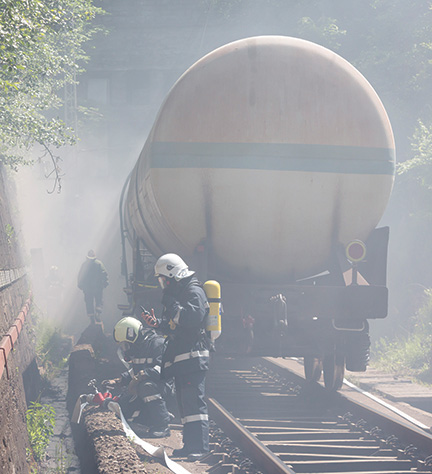Trouble on the Train Tracks
Drill Brings Staff Together for Emergency Response
By Bruce Gerson At 3 p.m., Aug. 10, a train pulling tanker cars of liquefied petroleum gas and other hazardous materials abruptly screeched to a halt and caught fire on the tracks under the bridge over Forbes Avenue near the Robert Mehrabian Collaborative Innovation Center (CIC).
At 3 p.m., Aug. 10, a train pulling tanker cars of liquefied petroleum gas and other hazardous materials abruptly screeched to a halt and caught fire on the tracks under the bridge over Forbes Avenue near the Robert Mehrabian Collaborative Innovation Center (CIC).
Thick black smoke billowed into the air and Pittsburgh Emergency Management ordered University Police to evacuate the campus to a quarter mile from the area.
Several sports camps and pre-college classes were in progress, and an international cybersecurity conference was in session at the CIC.
CMU’s Emergency Operations Center (EOC) sprung into action at the direction of Environmental Health and Safety Director Madelyn Miller, who was conducting her 10th annual Emergency Response Desktop Drill.
At tables spread throughout Rangos 1, more than 45 staff members from across campus representing the EOC’s Executive Policy Group, Unified Command, and Communications, Operations, Safety/Security, and Planning and Risk Assessment teams huddled and began to map out their emergency response strategies and activities.
A CMU-Alert message was drafted and sent to the campus community asking those in the affected zone to evacuate to their home or convene at the assembly area nearest them. Facilities Management Services moved to shut down air handling intake units in nearby buildings. The Student Health, Housing and Dining, and Safety and Security teams activated to accommodate for faculty, staff and students as well as the visiting campers, pre-college students and conference attendees.
After 15 minutes of planning each group gave an overview of what they discussed and what actions were taken, in addition to raising issues and concerns.
After round one, new developments building on the existing scenario were introduced, followed by more team planning, group discussion and debate.
Representatives from the City of Pittsburgh, George Washington University and the University of Maryland, Baltimore County (UMBC), where a train pulling hazardous materials really did catch fire, attended the drill and were surprised by the involvement of so many staff members in the room.
The drill included staff from Athletics, Computing Services, Conference and Event Services, Environmental Health and Safety, FMS, Housing and Dining Services, Marketing & Communications, Risk Management, Student Affairs, University Health Services and University Police.
“What was impressive about this was the number of groups what were at the table to bring up all the things that you don’t normally think about in an emergency,” said Patrick Wolf, assistant director of Environmental Health & Safety at UMBC.
“With any emergency response you’re never going to have all the answers. The question is do you have the ability to communicate within your group to start talking about these issues ahead of time. This is what planning is all about,” Wolf said.
Jonathan Henry, an emergency management specialist for the City of Pittsburgh, said he normally doesn’t see participation from so many university components at desktop exercises.
“I was pleased to see the acknowledgement from Mr. Henry as to the turnout from the many different departments. I think that shows the seriousness with which we take emergency response and planning,” said Vice President and General Counsel Mary Jo Dively of the Executive Policy Group.
“As in every one of these that I’ve attended in a decade, I learned new things that we can do better. They’re always valuable.”
The 10th annual drill was a first for Vice Provost for Research Gary Fedder.
“It’s always useful to bring people together from across the university to think about these types of things that otherwise we wouldn’t necessarily take the time to think about, and to learn of all the different connections we can make,” Fedder said.
George Nunez, director of Emergency Management at George Washington, said being able to assess what you can’t do is just as important as assessing what you can do.
“Any institution or organization needs to recognize what resources it has to be able to handle incidents and emergencies, but also when we don’t have the resources we must look outward to our colleague institutions, across the county or nationally for help,” he said.
Miller said it was heartening to see so many people participating and communicating.
“You can’t respond to a complex emergency if you don’t get people together,” she said.
